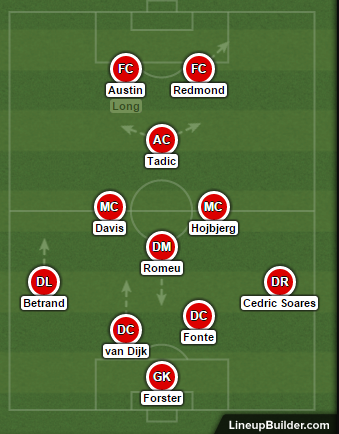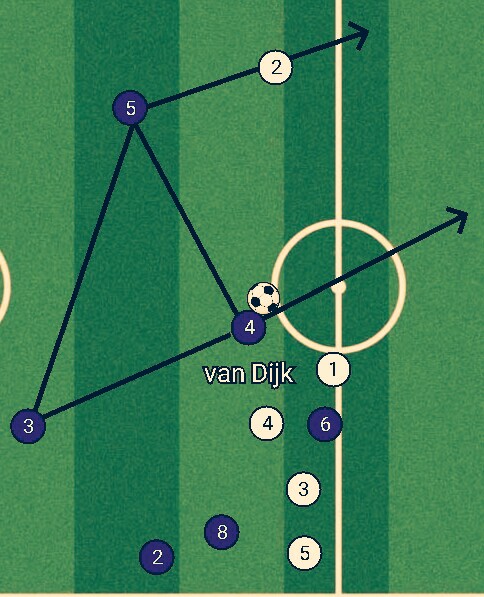
Breaking down lines
A major aspect of Virgil van Dijk’s game, is the array of ways in which the defender is able to break down phases of pressure and defensive lines during build-up play. First and foremost, one way in which this unorthodox approach to the modern centre-back role is undertaken, is through excellent ball carrying. Able to evade both lines/phases of pressure through combining strength, technical prowess and the ability to anticipate spaces, van Dijk often continues build up from deeper areas in a progressive sense, simply by carrying the ball into midfield.
In a recent 2018 FIFA World Cup qualifier in which the Netherlands beat Luxembourg 1-2, one passage of build-up play resulted in a free-kick which was subsequently scored by winger Memphis Depay. In the process of this passage of build-up, it was van Dijk who triggered the foul and this was because of shifting possession from defence to attack, which showcased two rather uncanny qualities;
- Admirable awareness of exposed space (which was a result Luxembourg’s poorly structured first phase, which is notable due to terrible spacing between players acting within the press ), before carrying the ball into and through that exposed space, located within the middle third, thus breaking down Luxembourg’s second phase.
- The solo run, in which van Dijk progressed from the lower to the final third, also led to winning a free-kick because of ability in 2 versus 1 situations. Being able to maintain possession of the ball while two opposition players attempt to press compactly attracts pressure from a greater amount of opposition and leaves further space exposed for teammates to run into.

Furthermore, the second act which Southampton’s #17 undertakes in order to evade defensive lines is through passing from deep. van Dijk is able to execute both long and short distanced passes, but what makes this an impressive quality however is the areas in which the passes are played into.
In similarity to Dutch compatriot Daley Blind of Manchester United, van Dijk is adept at taking advantage of spaces through vertical passes and playing diagonal passes in to the half spaces and wide areas, thus staying clear of potential blocks to passing lanes; A major aspect of Southampton’s chance creation is the width offered by either full-back (Cedric Soares/Cuco Martina and Ryan Bertrand respectively).
Usually deploying a 4-diamond-2, the narrow midfield requires the right and left full back to make overlapping for crosses to be played into the final third. for this to occur, either van Dijk, or a midfielder is required to play a diagonal ball to feet, or over the top of the defence.
- Composure in possession
- Passing range
- Keeps his position well and covers
- Resistance to first and second phases of press
- Ability to progress possession through movement into midfield
- Tackling
- Presses well, congesting space, thus forcing mistakes
Positional freedom
Great use of the half spaces by Virgil van Dijk is also exemplified through positional freedom from a centre-back role while with and without possession. This benefited the Netherlands in both attacking and defending aspects. For example, van Dijk’s choice of positioning on the left side of defence formed combinations with Daley Blind, who at left back, while offering extra width, still drifted inside within the lower-third to orchestrate build-up alongside van Dijk. The passes Blind received from van Dijk establish a sense of continuity within possession.
In a defensive sense, van Dijk’s positioning offered direct cover for Blind, who against Luxembourg, left space in behind on the left. van Dijk supporting Daley Blind in this way meant there were 2 versus 1 situations against Luxembourg’s winger. To add, van Dijk is adequate within 1 versus 1 duels, likely to press tightly, and on sporadic occasions, van Dijk will push into midfield to support the second phase, and upon winning the ball, begin counter attacks.
Holding on to possession (Hold up play)
Moreover, the progression of build-up play is ignited through holding onto possession. The maintenance of possession within defence attracts the deeper positioned trident of the midfield diamond, forming closer triangular networks, which requires less resistance to pressing manoeuvres from midfield players and van Dijk. Alternatively, when van Dijk is carrying the ball further forward, and is subsequently the higher positioned centre-back, van Dijk is also closer to midfield, but instead of the midfield dropping closer to the lower-third, the midfield would aim to maintain control of central zones (zones 8 and 11), with the pivot/defensive midfielder dropping alongside the remaining centre-back to add defensive cover.
Physicality
Possessing height in abundance, Virgil van Dijk takes like a duck to water in the air. The most successful player in the Premier League during the 2015-16 season in this department, van Dijk won a total of 158 Ariel battles. having showcased physical capabilities through excellent ball carrying skills, van Dijk is also capable of defending within the 18-yard box, consistently making blocks and clearances competently.
Perhaps the only improvement that would need to be made to Virgil van Dijk’s game is his concentration without possession, sometimes defensive lines can be disfigured through incoherent movement, which can be exposed though diagonal runs into the penalty area.